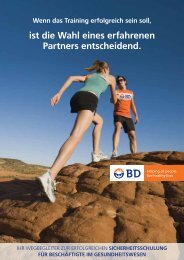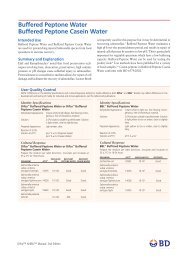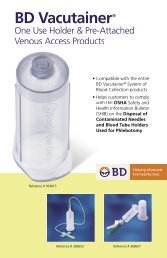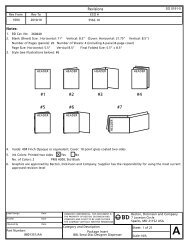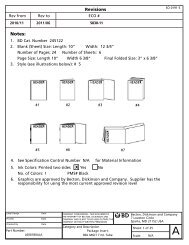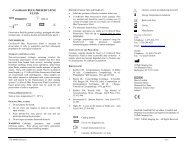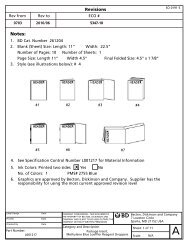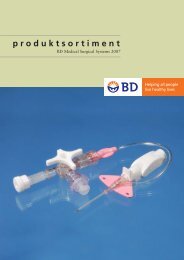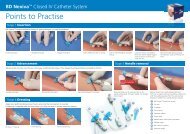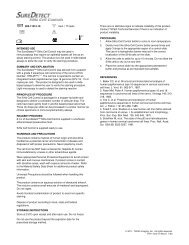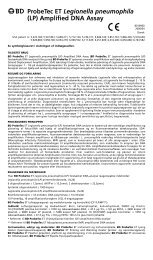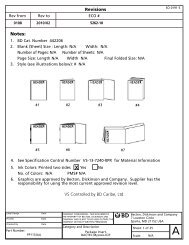MDifco Neisseria Meningitidis Antisera - BD
MDifco Neisseria Meningitidis Antisera - BD
MDifco Neisseria Meningitidis Antisera - BD
Create successful ePaper yourself
Turn your PDF publications into a flip-book with our unique Google optimized e-Paper software.
S1190_Difco<strong>Neisseria</strong>(0703).qxd 10/13/2003 11:33 AM Page 2<br />
Warnings and Precautions<br />
For in vitro Diagnostic Use.<br />
The Packaging of This Product Contains Dry Natural Rubber.<br />
Observe aseptic techniques and established precautions against microbiological<br />
hazards throughout all procedures. After use, specimens, containers, slides, tubes and<br />
other contaminated material must be sterilized by autoclaving. Directions for use<br />
should be followed carefully.<br />
Storage<br />
Store lyophilized and rehydrated Difco <strong>Neisseria</strong> <strong>Meningitidis</strong> <strong>Antisera</strong> at 2-8°C.<br />
Prolonged exposure of reagents to temperatures other than those specified is<br />
detrimental to the products.<br />
Expiration date applies to product in its intact container when stored as directed. Do<br />
not use if the product is caked, discolored or shows other signs of deterioration.<br />
SPECIMEN COLLECTION AND PREPARATION<br />
N. meningitidis can be recovered on blood agar or chocolate agar. For specific<br />
recommendations consult appropriate references. 4,5 Determine that a pure culture of<br />
the microorganism has been obtained and that biochemical test reactions are<br />
consistent with the identification of the organism as N. meningitidis. After these<br />
criteria are met, serologic identification can be performed.<br />
PROCEDURE<br />
Materials Provided: Difco <strong>Neisseria</strong> <strong>Meningitidis</strong> Antiserum Poly; Difco <strong>Neisseria</strong><br />
<strong>Meningitidis</strong> Antiserum Poly 2; Difco <strong>Neisseria</strong> <strong>Meningitidis</strong> Antiserum A; Difco<br />
<strong>Neisseria</strong> <strong>Meningitidis</strong> Antiserum B; Difco <strong>Neisseria</strong> <strong>Meningitidis</strong> Antiserum C; Difco<br />
<strong>Neisseria</strong> <strong>Meningitidis</strong> Antiserum D; Difco <strong>Neisseria</strong> <strong>Meningitidis</strong> Antiserum X; Difco<br />
<strong>Neisseria</strong> <strong>Meningitidis</strong> Antiserum Y; Difco <strong>Neisseria</strong> <strong>Meningitidis</strong> Antiserum Z; Difco<br />
<strong>Neisseria</strong> <strong>Meningitidis</strong> Antiserum Z’; Difco <strong>Neisseria</strong> <strong>Meningitidis</strong> Antiserum W135.<br />
Materials Required But Not Provided: Agglutination slides; Applicator sticks; Sterile<br />
purified water; Sterile 0.85% saline; Bacteriological loop.<br />
Reagent Preparation<br />
To rehydrate Difco <strong>Neisseria</strong> <strong>Meningitidis</strong> <strong>Antisera</strong>, add 1 mL sterile purified water<br />
and rotate gently to completely dissolve the contents.<br />
Equilibrate all materials to room temperature prior to performing the tests.<br />
Ensure that all glassware and pipettes are clean and free of residues such as detergent.<br />
User Quality Control<br />
At the time of use, test both positive and negative control cultures to check<br />
performance of the antisera, techniques and methodology.<br />
Quality control requirements must be performed in accordance with applicable local,<br />
state and/or federal regulations or accreditation requirements and your laboratory’s<br />
standard Quality Control procedures. It is recommended that the user refer to pertinent<br />
NCCLS guidance and CLIA regulations for appropriate Quality Control practices.<br />
Test isolate for autoagglutination<br />
1. From the test culture on chocolate agar, transfer a loopful of growth to a<br />
drop of sterile 0.85% saline on a clean slide and emulsify the organism.<br />
2. Rotate the slide for one min, then observe for agglutination.<br />
3. If agglutination (autoagglutination) occurs, the culture is rough and<br />
cannot be tested. Subculture to chocolate agar, incubate and test the<br />
organism again as described in steps 1 and 2.<br />
4. If no agglutination occurs, proceed with testing the organism.<br />
Choice of antisera<br />
Test the organism first with Difco <strong>Neisseria</strong> <strong>Meningitidis</strong> <strong>Antisera</strong> Poly, Poly 2, Group<br />
Z’ and Group W135. Depending upon the reaction, continue testing according to<br />
either a, b or c listed below.<br />
a. If agglutination occurs with Difco <strong>Neisseria</strong> <strong>Meningitidis</strong> <strong>Antisera</strong><br />
Poly or Poly 2, test the organism with the monospecific antisera<br />
indicated:<br />
If positive reaction Retest with<br />
with this antiserum: these antisera:<br />
Poly A, B, C and D<br />
Poly 2 X, Y and Z<br />
b. If agglutination occurs with Difco <strong>Neisseria</strong> <strong>Meningitidis</strong> Antiserum Group Z’,<br />
test the organism with monospecific Difco <strong>Neisseria</strong> <strong>Meningitidis</strong> Antiserum<br />
Group Z. Cultures of N. meningitidis group Z’ will not agglutinate Difco<br />
<strong>Neisseria</strong> <strong>Meningitidis</strong> Antiserum Group Z. However, cultures of<br />
N. meningitidis group Z will agglutinate Difco <strong>Neisseria</strong> <strong>Meningitidis</strong><br />
Antiserum Group Z’. The expected agglutination patterns are as follows:<br />
<strong>Neisseria</strong> <strong>Meningitidis</strong> <strong>Neisseria</strong> <strong>Meningitidis</strong><br />
Organism Antiserum Group Z’ Antiserum Group Z<br />
N. meningitidis group Z’ 3+ –<br />
N. meningitidis group Z + 3+<br />
c. If agglutination occurs with Difco <strong>Neisseria</strong> <strong>Meningitidis</strong> Antiserum W135, no<br />
further testing is necessary.<br />
2



